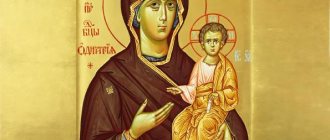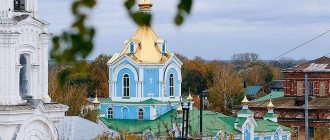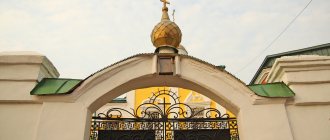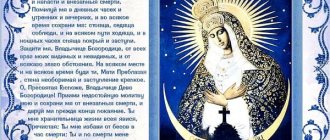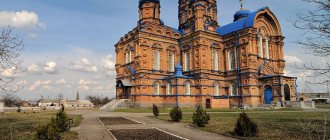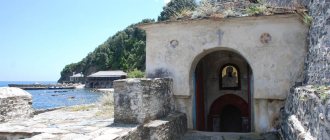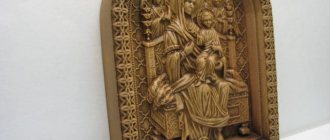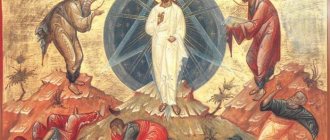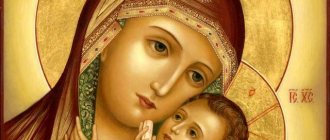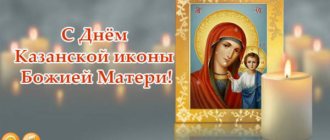Certain life difficulties await every person. Illness, financial problems, difficulties in relationships with loved ones - all this is inevitable on the path of life. In sorrow and joy, Orthodox believers turn to their main helpers - the Lord, the Most Holy Theotokos, saints and angels.
Purchase the icon of the Mother of God Hodigitriya on this page /catalog/ikony/bogoroditsy/bogoroditsa-odigitriya/. We will deliver your purchase quickly and accurately.
Traditionally, Christians pray in front of images of those to whom their requests are addressed. Since the faithful intercessor of the Orthodox is the Mother of God, it is not surprising that there are many shrines on which the Heavenly Lady is depicted.
One of the most revered shrines among the people is the icon of the Mother of God Hodegetria. How does this image help? Why do believers treat this shrine with such love? What's its story? If you want answers, then read the article further!
Image and compositional features of the holy image
The main theological idea for the image was the theme of the coming of Christ, who became the incarnation of the Lord himself on Earth, for the sake of the salvation of every human soul. The board depicts the Mother of God holding the Christ Child in her hands. The fragile baby is the embodiment of the Heavenly King, who is coming to judge this world and every person.
A characteristic feature of this image is the unique placement of the hand of the Mother of God - she raised her right hand as if pointing people to Christ, telling whom they should worship and pray. It can also be interpreted as a personal appeal of the Mother of God to Jesus.
Researcher Kondakov argued that this image is the oldest of all that have reached the modern church. Initially it was known in Palestine, and after the 6th century it spread widely and became known throughout Byzantium and the East.
The composition of the iconography is very interesting:
- All characters are depicted frontally so that their faces do not touch each other. They seem to be detached;
- The person praying can clearly see the face of Jesus and His Mother;
- The face of the Virgin Mary is slightly inclined towards the child;
- The right hand is raised to chest level, where it is frozen, in a prayer gesture;
- Jesus is positioned in his arms;
- Christ's right hand blesses, and in his left there is a parchment (in some variations he holds a book instead of a whistle);
- The Queen of Heaven is depicted from the waist up, but in the world there are variants of the board where she is depicted in full height or, on the contrary, only up to the shoulders;
- On some similar icons the Child is located on the right side.
There is no exact information about how exactly the Smolensk Icon of the Mother of God came to the territory of Rus', however, since its appearance, the board has been revered and considered a precious shrine by all members of the Orthodox Church. Few Orthodox Christians did not know this image and did not pray to it.
Special attitude towards the Mother of God in Rus'
So, the Hodegetria icon in Rus' is quite popular and very revered. Evidence of this is the numerous lists of the first image that spread throughout Ancient Rus'. It should be noted that the Mother of God is favorable to people living in this territory, since in many areas she is considered a patroness and intercessor.
Very often, sincere prayer saved a person from some misfortune or misfortune. There is a lot of evidence of this, both in ancient times and today.
History of the image
The author of the board, according to church tradition, is the Apostle Luke, whose gospel can be found in the New Testament. The board was discovered and transported to Constantinople from Palestine in the 5th century as part of other shrines by Empress Eudokia, whose husband was Emperor Theodosius the Younger.
According to surviving sources, it can be calculated that the board was initially kept in the Odigon convent, and on Easter days it was moved to the imperial palace. The monastery was already famous for its miracles at that time and was called Odigon or “Guide”, and later the shrine kept in it began to be called “Hodegetria”.
Important! The name “Hodegetria” perfectly suits the board not only in the place of its original storage, but also in the spiritual sense, because the Mother of God is the guide of all people to the Lord, who guides them to the truth and saves them from enemies. This portrait became one of the main ones in Constantinople - it was the one that was raised on the city walls during a siege, protecting the city from enemies.
Many historians confirm that this particular board became the main one in the procession. The miracle that occurred during this move is also known: according to the records of Stefan of Novgorod, who was a pilgrim in Constantinople, the picture of the Mother of God was carried through the streets and squares, but the miracle was that the heavy image was in a beautiful wooden frame, weighing at least 10-20 kg was worn by only one person throughout the entire course, which lasted about 4-6 hours. Isn't this a miracle?
More about miracles in Orthodoxy:
- Miracles and help of the Mother of God
- Barnaul miracle of Claudia Ustyuzhanina
- Lanchang Miracle
In the 11th century, the Mother of God Hodegetria entered the territory of Rus' as part of the dowry that Emperor Constantine gave for his daughter Anna during the wedding with Prince Vsevolod. When Vsevolod died, his son Vladimir Monomakh ordered the foundation of the Church of the Assumption of the Virgin Mary in Smolensk, where the holy inheritance was located. After this, Lik became the defender of the city. The first significant miracle occurred in 1239 during the siege by the army of Batu Khan. The warrior Mercury prayed to Hodegetria for a long time and received a revelation - to fight the enemy alone. According to the testimony of many Mongols, during the battle of Mercury there were angels and the Mother of God herself who fought with him. The Mongols fled, horrified by what they saw, and Mercury died there and became one of the saints of the Orthodox Church.
The appearance of Hodegetria
According to legend, the author of the very first icon was the Evangelist Luke , a disciple and associate of the Apostle Paul.
He painted this image during the life of the Mother of God at the request of the ruler of Antioch, Theophilus. Also, this icon originally contained a piece of the maforia (robe) of the Mother of God. Subsequently, the icon of the Mother of God Hodegetria came from Antioch to Jerusalem, and from there the Byzantine Empress Eudokia transported it to Constantinople. The Hodegetria was placed in the Blachernae Church, which is where its second name came from - the Blachernae Icon.
As for the origin of the word “Hodegetria” itself , there are three versions:
- After the Blachernae Temple, the icon was kept for a long time in the Byzantine monastery of Odigon, from which its name was derived.
- According to legend, one day the Mother of God appeared before two blind men and miraculously led them to the temple in Blachernae. Presenting themselves before her icon, they immediately regained their sight, and from that time on the image began to be called Hodegetria, that is, “Guide”.
- With a list of this icon, Emperor Constantine blessed his daughter Anna, who was marrying a Russian prince and was supposed to go to Russian lands. Her journey was long and difficult, and only thanks to the miraculous image, the princess was able to reach her future husband.
Where can you see the icon
At the beginning of the 15th century, the icon of Our Lady Hodegetria was moved to Moscow . The exact cause is unknown, but there are three versions of this event:
- Dynastic marriage of a Lithuanian princess and the Prince of Moscow;
- The inheritance of the last prince Yuri Svyatoslavovich, who was expelled by Vytautas and took everything with him;
- As part of the loot of Yurga, when he left Prince Svidrigail and went to serve the Moscow Prince Vasily Vasilyevich.
During his stay in Moscow, several copies were written from the holy face. In 1456, the original image returned to Smolensk, after the Moscow prince Vasily the Dark returned it as a future reunification of the two cities. At the same time, a copy was written and left in Moscow in the Annunciation Cathedral. On the copy, the infant Christ is positioned vertically, and researchers are inclined to think that this is how Jesus was depicted in the original Byzantine image. Later, the Mother of God of Smolensk was brought to Moscow several times to perform prayer.
The day of the Battle of Borodino was especially significant, when many holy faces, including Smolensk, were gathered in the Muscovites' religious procession. During the war with the French, the face was transferred to storage in the city of Yaroslavl for preservation and protection.
Important! In 1941, the Hodegetria, which was brought from Byzantium, was lost and it is suspected that it was stolen. A copy of the image is now kept in the Armory Chamber, where it came from the Novodevichy Convent, built in 1523. They did this for safety reasons, because the frame of the board is decorated with a rich gold frame and a pearl chasuble.
What do they pray to the icon for?
The prayer to the Smolensk Icon of the Mother of God has been revered by many Christians for many centuries and helps incredible miracles happen. Smolensk “Hodegetria” is considered the patroness of travelers; they ask her to protect them from unpleasant situations, various diseases, and unforeseen troubles along the way. All those who suffer also pray to her, asking her to protect and preserve their home from ill-wishers and enemies. Throughout history, Christians have asked for help from the Smolensk Mother of God in times of severe mass epidemics.
What does Hodegetria help with?
Our Lady of Smolensk often moved, being located either in the churches of Moscow or in the cathedrals of Yaroslavl, and only in 1655 was she returned to Smolensk, where today you can bow and pray to her, the rights are no longer to the original image, but to a copy. Initially, the holy image was placed in Constantinople, which was saved many times by her. After all, it was before Hodegetria that many believers prayed for peace in the city and for an end to hostilities. She guarded first Byzantium, and now Russia, protecting it from military operations, destructive natural phenomena and terrible epidemics.
What do Orthodox Christians pray for before this image? They believe that the face:
- will protect the native land from hostilities and bloodshed;
- will protect those who are in the army and at the front;
- protects against diseases and epidemics;
- will protect every family;
- will patronize family people.
What else can you pray to the Mother of God for:
- Prayer before the icon “Softening Evil Hearts” for reconciliation
- Prayer before the icon “Inexhaustible Chalice” against drunkenness
- Prayer before the icon “The Queen of All” to get rid of cancer
This image represents a symbol of protection from harm and a symbol of health. They pray to the icon for the salvation of the family, for the protection of loved ones and relatives, for those who are far from their home. Those who go on a journey or business trip also ask for the protection of the Mother of God. The mother asks for the protection of the children, and the children ask for the health of their parents.
SMOLENSK ICON OF THE MOTHER OF GOD, CALLED “HODEGETRIA”
Meaning of the image
“Hodegetria” is one of the most famous and revered shrines in Russian churches. Stunning historical events are associated with the Smolensk image. During the icon's travels through the western Russian regions, she became a participant in the most important historical events in the history of the country. Not a single important event took place without the participation of “Hodegetria”. The “Guide” defended the country’s western borders from the invasion of enemies who more than once tried to establish their own influence on Russian soil. Even a temporary retreat under the pressure of enemies was a strategic plan, and not an agreement to surrender and tolerate strangers on one’s land. The joint prayers of Smolensk and Muscovites produced a unique result. The enemy retreated sooner or later. An interesting fact is that “Hodegetria” always returned to its homeland, to Smolensk.
Celebration
The veneration of the Smolensk Icon occurs three times a year. On August 28, the day of the image is celebrated. This date was chosen in 1525. Her choice was connected with the transportation of the icon from the Moscow Kremlin to the temple at the Novodevichy Convent, which was built as a sign of gratitude for the return of the Smolensk lands of Rus'.
The celebration takes place again on November 5 in honor of the victory in the Patriotic War of 1812. And November 24 is the day of remembrance of the victory of the Smolensk residents over the army of Batu Khan.
Temples that are dedicated to the image of “Hodegetria”
Having considered the question: “Hodegetria - what is it?” — it should be noted that other shrines also correspond to this image. For example, in many cities both in Russia and other countries, there are temples that were built in honor of the image of the “Guide”. Let's look at the list:
- church in Kimzha, located in the Arkhangelsk region (not active);
- church in the city of Disna, Belarus (operating);
- chapel-temple of Hodegetria, it is located in Simferopol, Crimea (operating);
- Church in Kasimov, located in the Ryazan region (operating).
And there are quite a large number of such churches, chapels and temples, since the veneration of the Mother of God by the Orthodox is great.
Other famous icons of this type
The Hodegetria of Smolensk icon is, of course, the most famous among others of this type. However, there are many others similar to it. One of these icons is the Georgian one. Initially, it was in Georgia, but after 1622 it was taken to Persia (after the conquest of the country by Shah Abbas). Her journey was long, and it stopped in the Arkhangelsk province at the Krasnogorsk monastery. Today, the original image is lost, but there are copies of it. Prayers are offered in front of the icon for the sake of deliverance from various epidemics, as well as to be cured of ear and eye diseases.
Another, no less important, icon depicting the Mother of God Hodegetria is the Iverskaya. This image has an equally mysterious history. In the 9th century, she was in the house of a pious woman. It was an iconoclastic period, and she decided to save the icon from destruction by lowering it into the waters of the sea. The icon appeared only two centuries later near Mount Athos near the Iveron Monastery. A gate church was built for her, where the image is still preserved.
Of course, these are not all the images of this type, which are kept and revered in many monasteries and temples. There are quite a few of them, and they all have their own special powers and provide protection.
